Alaska is famous for its wilderness and wildlife. Last week I took a group of nine there for a photography adventure, and the state certainly lived up to its reputation.
We started and finished in Anchorage, and about half of us flew in a day early and wanted to do something other than sit around with that extra day. So I planned an outing on the Seward Highway along Turnagin Arm, a body of water off of Cook Inlet that stretches southeast from Anchorage. We stopped at Potter’s Marsh (a bird sanctuary), Beluga Point, Chugach State Park, the Alaska Wildlife Conservation Center, Portage Lake and Byron Glacier. The best stops were Potter Marsh, Chugach, the AWCC and hiking in to Byron Glacier, so I plan to re-visit those on the next workshop I lead there in 2021. We returned to Anchorage for dinner and then pack for tomorrow’s trip into a bear camp.

We spent about an hour exploring around McHugh Creek, in Church State Park, and it was time well spent. There were several spots we could get close, and despite being early August, fall color was on its way. With the in-body stabilization of the Nikon Z7 and braced on a rock, I was able to avoid using a tripod. Nikon Z 7, ISO Aperture Priority, ISO 100, 1/6 second, F/11, EV -.3, Nikkor 18-35mm lens at 18mm.

The Alaska Wildlife Conservation Center is well worth the $16 entrance fee. Loads of native Alaskan wildlife, like these caribou, in enclosures that look natural with fences just large enough to stick a lens though. I chose a low angle here to emphasize the size of the antlers on this buck. Nikon Z 7, Aperture Priority, ISO 200, 1/400 at f/10, EV -1.0, Nikkor 18-35mm lens at 18mm.
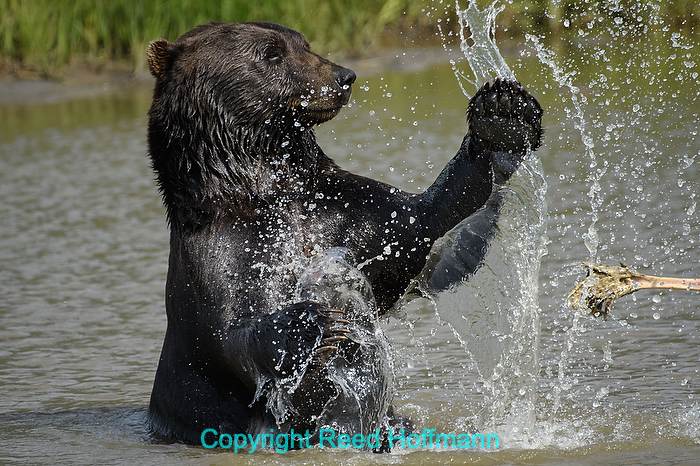
The AWCC also has three “Coastal Brown Bears,” which for those of us in the lower 48 translate as “grizzly.” However, they’re larger than the grizzlies we’re used to, as they have a richer diet. This one was playing with its food, a leg bone, probably from one of the local caribou. Nikon D500, Aperture Priority, ISO 320, 1/1600 at f/5.6, EV -.3, Nikkor 200-500mm lens at 500mm.
The following morning we left Anchorage for the three-hour shuttle drive to Great Alaska Adventures Lodge. Once there we checked in, got ourselves and our gear weighed and were assigned our bush plane flights to their bear camp. That one small plane would ferry us in on three separate flights, and since we’d booked as a large, private group, we were allowed 35-pounds each to bring for our stay there. Normal bookings are limited to 20-pounds/person, which would be hard to stay under for a photographer. Even a 35-lb limit can be challenging for a multi-day wildlife photography trip. For camera gear, I took my Nikon Z 7 and D500 cameras (I prefer a DX camera for most wildlife photography), Nikkor 24-120mm and 200-500mm lenses, five batteries, extra cards, , XQD reader, charger, carbon-fiber monopod and lightweight rain covers. I also brought along my 3-lb laptop (without AC brick), to download pictures each day. For clothing, just the clothes and boots I was wearing, plus two extra shirts, underwear and socks, rain jacket and pants, fleece vest, thin gloves, sun hat, thin watch cap, thin gloves and headnet. My total weight for this kit was 30 pounds. I left a large roller duffle back at the main lodge with more clothes and camera gear for when I returned from bear camp.
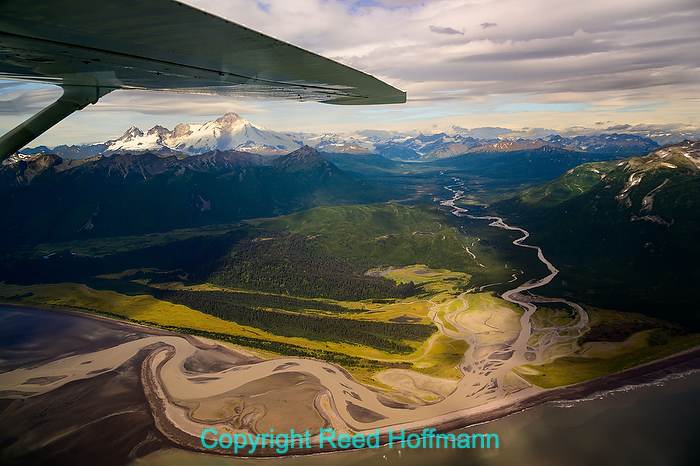
We had some spectacular views of Mt. Iliamna, a ten-thousand foot active volcano that dominates the horizon near Chinitna Bay, our home for the next three days. Nikon Z 7, Aperture Priority, ISO 320, 1/800 at f/8, EV -.3, Nikkor 24-120mm lens at 24mm.
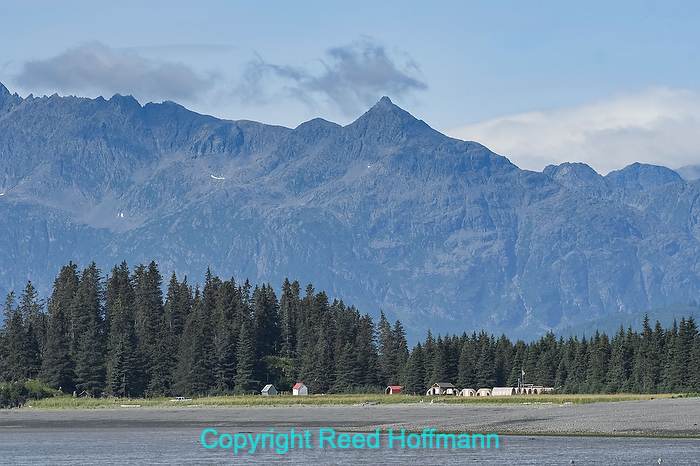
Here’s the site of our camp on Chinitna Bay in Lake Clark National Park. You can see our tents at right, with the larger gazebo in front. The three buildings to the left are part of the old homestead, now a protected and preserved area. Nikon D500, Aperture Priority, ISO 200, 1/2500 at f/5.6, -0.3 EV, Nikkor 200-500mm lens at 200mm.
After a 45-minute flight, we landed on a gravel beach (landings and take-offs are only done at low tide) and were met by camp staff with one of the trucks they use to haul people around. They told us there was a bear hunting clams nearby, and would we like to go? Silly question. A few minutes later, we were kneeling on the sand taking pictures of a large coastal brown bear digging for clams. And that was our introduction to the lives of the bears in that area. The reason they have a large concentration of bears there is four-fold. One, the mountainside nearby makes for good denning for the bears as they hibernate through the long winter. Two, the large, open meadows are filled with sedge, which is a grass high in protein that the bears gorge on after coming out of hibernation. Three, the mud flats at low tide make for an easy meal of clams throughout summer. And four, in late summer (usually early August) they can feast on salmon as the fish make their way upstream to spawn. Alaskan coastal brown bears are larger than the inland species (grizzlies) because they have a richer diet. We’d planned our trip for early August in hopes of catching them fishing.
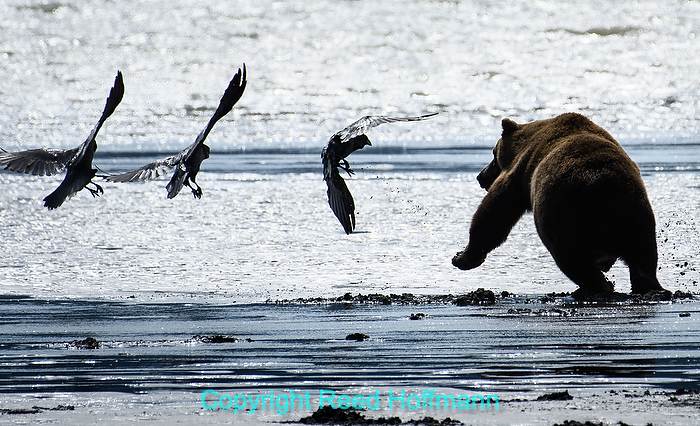
If a bear’s doing well clamming, it will have a group of gulls and ravens near it. And occasionally, it will chase them off. Nikon D500, Aperture Priority, ISO 200, 1/2000 at f/5.6, EV +.3, Nikkor 200-500mm lens at 500mm.
The camp itself is composed of ten, two-person tents on wood platforms. The tents aren’t regular camping tents. They’re more like small Quonset huts, with metal frames covered by fabric, with solid doors and real beds. There’s a small propane heater if you need it at night (we didn’t) and a porta potty behind a curtain for the ladies to use at night (men are asked to just step outside). The rest of the time we use the two bathrooms with running water and composting toilets (a less smelly version of a pit toilet). There are also two showers, and meals are served in the dining tent. While we came prepared with bug dope, we only encountered a few (I never applied the spray), although we were told that at times it can be buggy. The entire camp area is surrounded by a small electric fence that you could step over. While it would be easy for a bear to push through it, they’ve learned to avoid it, and adjusted to the presence of the camp that’s been there for over twenty years.
There’s just one other permanent camp on that side of Chinitna Bay, about a mile away. Aside from them, the only other people we’d see were folks flying in from Homer with hopes of seeing bears. For about $600 you can take a bush plane in, land on the gravel and follow a guide in search of bears for a couple of hours. If they aren’t clamming, your odds of getting anywhere close is pretty slim. You can almost always see bears from a distance (a mile or more away), but as photographers, that’s not optimum.
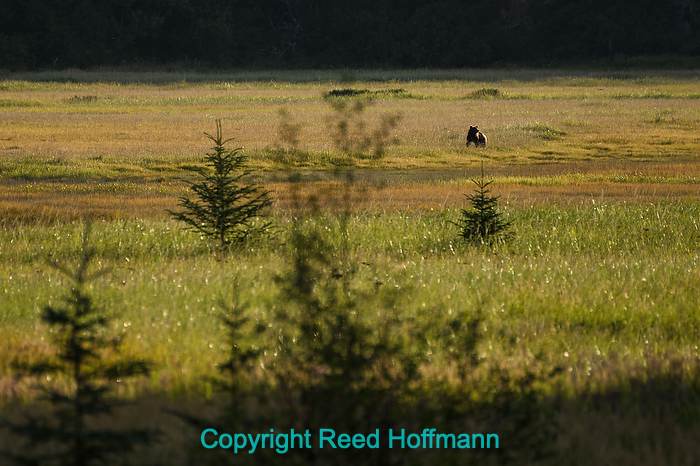
We’d occasionally take the trails out to the sedge meadows to look for bears. While that could result in a nice wider shot like this, the bears were never close enough there for tight photos. For a good variety of pictures for a story, though, you do need more than just the tight shots. Nikon D500, Aperture Priority, ISO 400, 1/1000 at f/5.6, EV -.7, Nikkor 200-500mm lens at 500mm.
The whole area is part of Lake Clark National Park, the third least visited national park in the United States (not surprisingly, the other two are in Alaska as well). There are no roads in this national park, the only access being by foot, aircraft or boat. There’s actually a ranger station not far from our camp, and she us visited one evening to tell us about the history of the park and its wildlife. The reason our camp (and the other) is allowed there is because it was there before the area became a national park. We toured the buildings that made up the homestead at our spot, and learned about the man who lived alone year-round, fishing and trapping. He spent the last 37 years of his life in that pristine location.
Among the small camp staff are three guides who are in charge anytime we go outside the fence. They always carry bear spray, and sometimes a shotgun, depending on where we’re going. There are three areas we can visit, the further ones aboard a small truck set up to carry up to fifteen passengers. At low tide, there are mudflats along the beach where the bears like to dig up clams. You can also access a pair of National Park Service trails from the beach, through woods to viewing areas for those meadows where they feed in early summer. The best spot is a private one belonging to our camp, a two-story platform that overlooks a creek out back. That’s the key place to try to find bears fishing, when the tides are right.
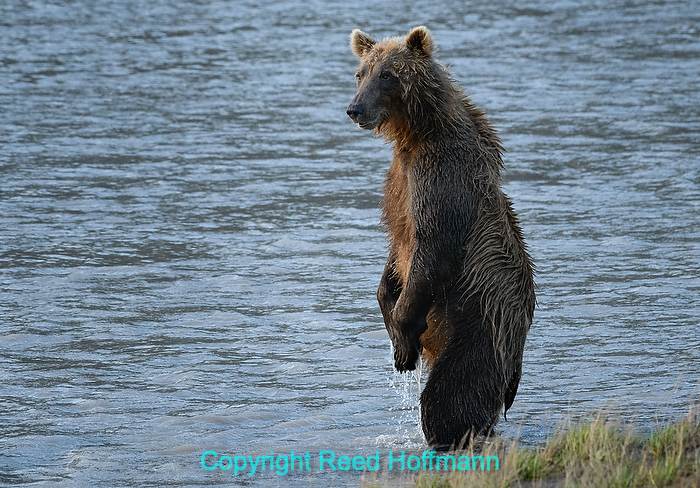
When fishing, the bears would often stand up to get a better view of the salmon in the creek. This bear put on quite a show for us on the platform, making several catches. Lucky for us we still had daylight, as it was nearly 10pm when he started fishing. Nikon D500, Aperture Priority, ISO 2800, 1/800 at f/5.6, EV -.3, Nikkor 200-500mm lens at 290mm.
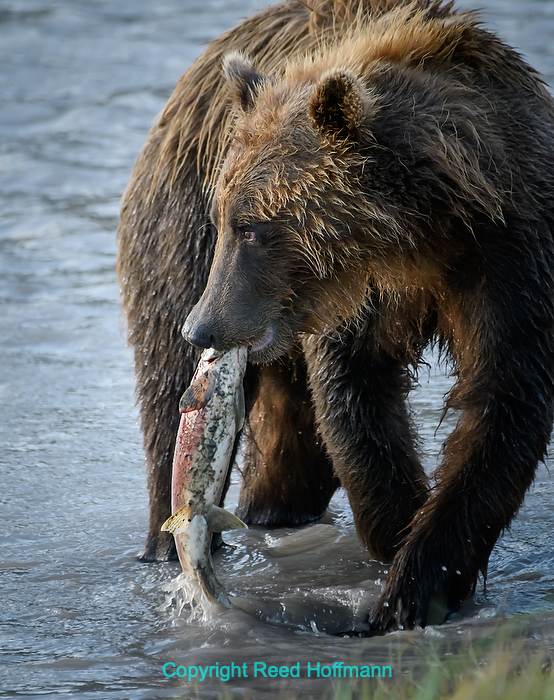
Same bear, bringing a catch onshore to dine near us. Nikon D500, Aperture Priority, ISO 3200, 1/400 at f/5.6, 0.0 EV, 200-500mm lens at 500mm.
We arrived Sunday afternoon and were there three nights, leaving Wednesday afternoon. During that time, the guides would alternate, taking us out every morning, afternoon and evening. With sunrise around 5:30am and sunset around 10:30pm, we had lots of time to look for bears. Meals were surprisingly good considering the remoteness, and the solar panels provided all the AC we needed for charging batteries. All three mornings we had bears visit the edges of the camp before breakfast (at 8am), and we saw bears every time we went out. Not always close enough for good pictures, but still, bears! The “half-hour happy hour” was usually spent sitting in the gazebo enjoying a drink and the view of the bay, and after dinner we’d always head out back to the platform for more watching and waiting.
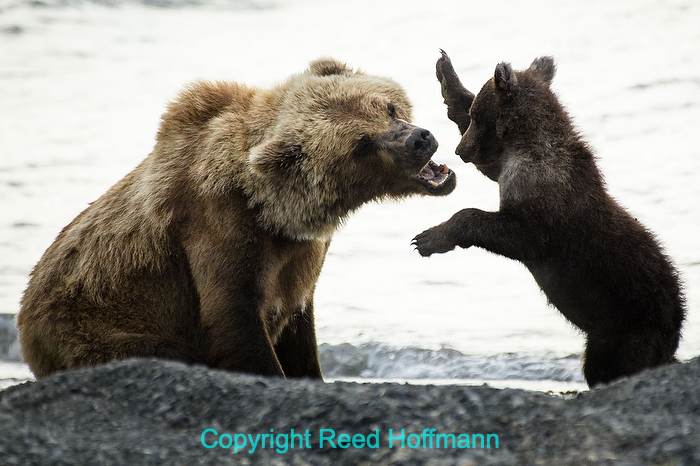
One morning just after breakfast we were treated to a sow and cub playing on the beach right in front of our camp. If a mother has only one cub, she takes on the role of playing with it to teach it how to fight as an adult. Heavily backlit, I used some plus exposure compensation and then opened up the shadow tones while editing the RAW file. Nikon D500, Aperture Priority, ISO 320, 1/1000 at f/5.6, +0.7 EV, Nikkor 200-500mm lens at 500mm.
While I normally carry an ultra-wide zoom, this time, because of weight constraints, I only brought along the Nikkor 24-120mm. Expecting to use the 200-500 most of the time (which is what I did), I didn’t think I’d need the wide zoom much. Unfortunately, my 24-120 had suffered impact damage a few years ago (a polite way of saying I dropped the lens), which meant the zoom was stiff. When that happens, you should really get the lens repaired ASAP, as it could lock up and be unable to zoom at all. Since I’d neglected to do that, it locked up on me the first night at bear camp, giving me a lens functional only from 100-120. Fortunately, I was able to borrow a wide-angle from others in the group for the few times I really needed a wide. But, lesson learned, if a lens is even only slightly damaged, get it fixed before any important trip. Once back to the main lodge where the rest of my gear was, I could use the Nikkor 18-35mm lens I’d left there.
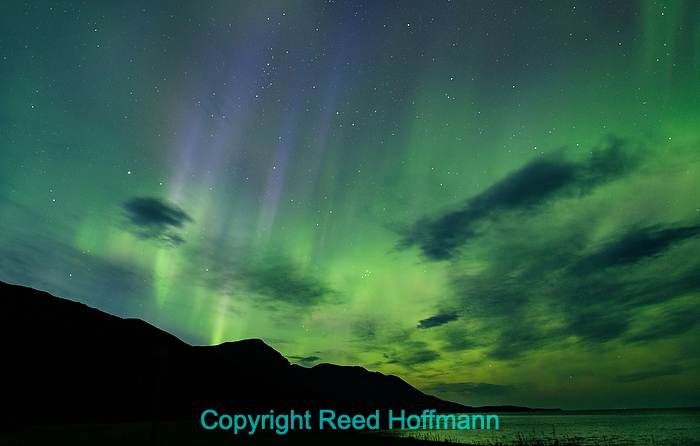
It had only been in the last week or two that nights had gotten dark enough for stars to be visible, so our guides were surprised when we had a bit of northern lights the first night. One of them woke us around 1:30am to come out and see the show. After helping one of my clients get her focus and exposure right, I borrowed her camera and lens to shoot my own picture. Nikon D850, Manual exposure, ISO 2000, ten-seconds at f/4, Nikkor 24-1200mm lens at 24mm.
For exposure, I kept my white balance at the Sunny Daylight setting and was often using Auto ISO. With the combination of a long lens and possibility of action, I often set my base ISO at 200, my maximum at 4000, and a minimum shutter speed of 1/1600. Working in Aperture Priority, I’d keep the 200-500mm lens wide open at f/5.6. Since it’s sharp wide open, why sacrifice either shutter speed or ISO by closing it down? If there wasn’t action, I’d turn off Auto ISO and manage it manually, or simply change the minimum shutter speed to a lower number.
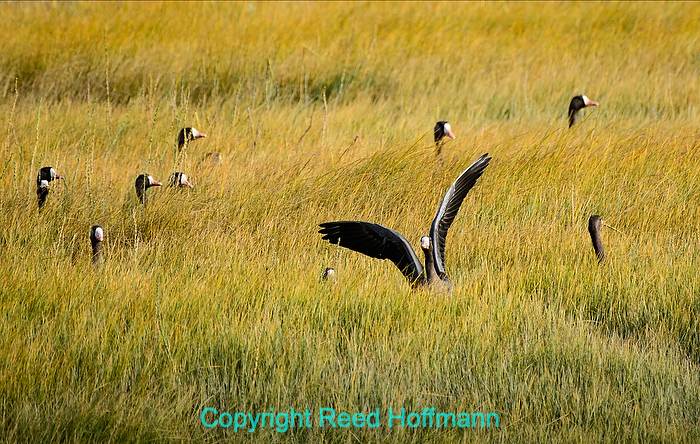
A flock of white-fronted geese took up residentcein the field across from the viewing platform, which was a first for the guides there. For us, it was a welcome excuse to shoot some photos while waiting for bears to show up. Nikon D500, Aperture Priority, ISO 560, 1/1600 at f/5.6, EV 0.0, Nikkor 200-500mm lens at 500mm.
After returning to the main lodge in Sterling, we spent three more nights there, doing an outing each day: a float trip on the Kenai River, a wildlife viewing trip on a large boat in Kenai Fjords National Park and a hike to Russian River Falls to watch salmon fighting their way upstream.
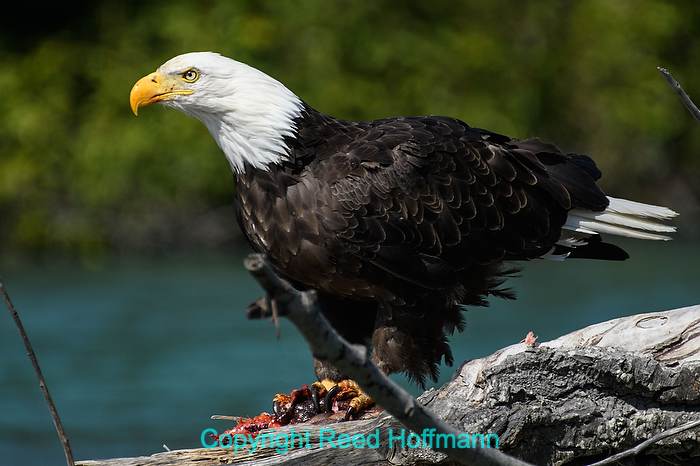
On the first day back from camp we took a float trip with Alaska Rivers Company on the Kenai River. We saw many eagles, but none better than this one perched on a log in the middle of the river feeding on a fish. With the raft moving, bouncing as people shifted position, I only got a few frames sharp. Luckily, I only needed one. Nikon D500, Aperture Priority, ISO 360, 1/2000 at f/5.6, -1.3 EV, Nikkor 200-500mm lens at 500mm.
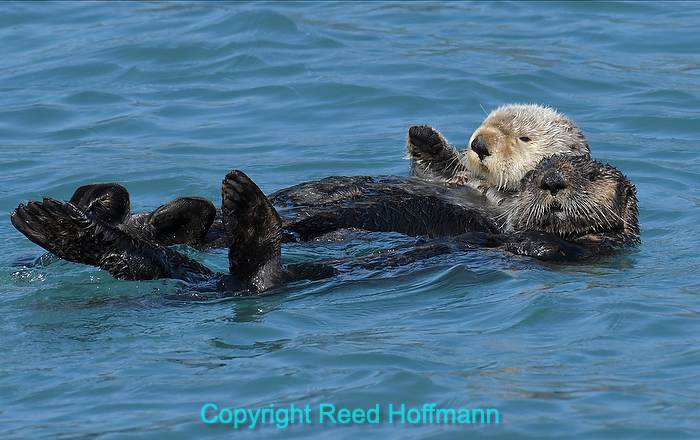
Only a few minutes into the Kenai Fjords trip we were lucky enough to come across this pair of sea otters, They have the densest fur of any animal, up to one-million hairs per square inch. Nikon D500, Aperture Priority, ISO 500, 1/1600 at f/5.6, EV 0.0, Nikkor 200-500mm f/5.6 lens.
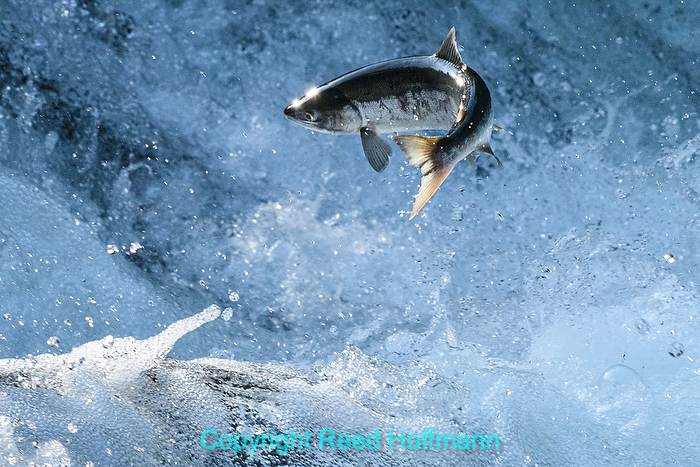
We had to hike in a little over two miles to Russian River Falls, but it was well worth it to watch sockeye salmon trying to fight their way up the falls. To make this picture I found a spot fish were regularly jumping, then framed the shot, balanced the lens on my knees and watching over the camera fired when I saw a fish jump. Because I couldn’t be sure of focus where they jumped, I also raised the ISO to allow for a smaller aperture, hoping depth of field would save me. Out of hundreds of frames, I got a few good ones, and this is the best of those. Nikon D500, Aperture Priority, ISO 1600, 1/1600 at f/11, +0.3 EV, Nikkor 200-500mm lens at 200mm.
All in all it was a fantastic trip, and I’ll take another group in 2021. If you’d like to know when we have the details finished, drop me an email and I’ll add you to the “notify” list. In the meantime, here are a few more photos from our adventure…
(If you like this story, please share it with your friends and let them know about the links on photography that I post on my business Facebook page. I’m also on Instagram and Twitter, @reedhoffmann. And if you’re curious about the workshops I teach, you can find them here.)
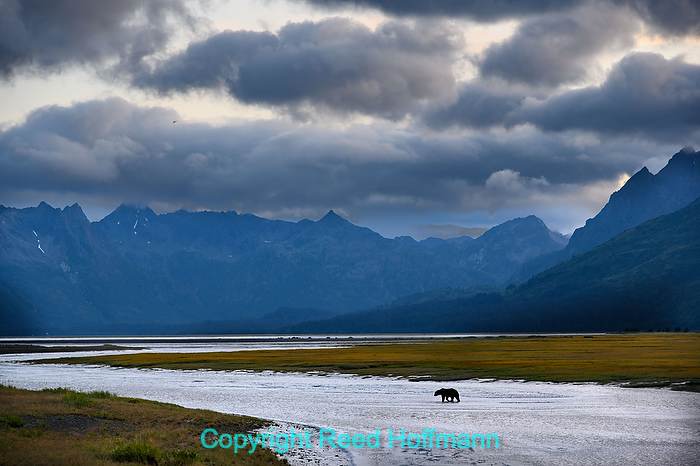
This is the creek we could watch bears fishing in, that flows in and out of Chinitna Bay (in the background) depending on the tides. Despite occasionally threatening clouds, Alaska’s dry summer continued during our visit, so we stayed dry too. Nikon Z 7, Aperture Priority, ISO 640, 1/200 at f/5, EV -.7, Nikkor 24-120mm lens at 105mm.
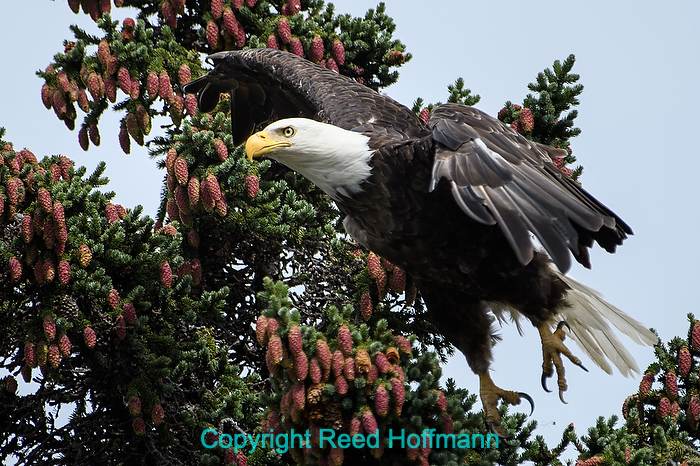
We saw bald eagles regularly, as they watch for bears catching salmon and then try to scavenge the leftovers. We even saw one steal a freshly caught salmon after a bear had walked back to the water to look for more. Nikon D500, Aperture Priority, ISO 220, 1/1600 at f/5.6, EV -.3, Nikkor 200-500mm lens at 500.

Whether fishing or clamming, the bears draw others to share in the bounty. We’d see gulls and ravens regularly, and occasionally an eagle. The group leaving the camp when we arrived even saw a wolf one night looking for leftovers. Nikon Z 7, Aperture Priority, ISO 12,800, 1/500 at f/5.6, EV -.7, Nikkor 200-500mmm lens at 500mm.

And sometimes the bears could look a little dopey. Our last morning there we had a big one out in the creek behind camp, and watched him scratch, yawn and nap along the river. As much as we wanted to see him fish, he was just taking it easy. Nikon Z 7 in DX crop mode, Aperture Priority, ISO 360, 1/1000 at f/5.6, EV 0.0, Nikkor 200-500mm lens at 500mm.

While that last bear wasn’t keen on fishing, he wasn’t beyond coming over by our platform to clean up some fish leftovers from an earlier hunt. At this point he was within twenty feet from us, and when he left and I turned around, I found the guide behind me with his bear spray out, ready in case the bear became too interested in us. Experienced guides are a must in places like this. Nikon D500, Aperture Priority, ISO 1800, 1/800 at f/5.6, EV -.3, Nikkor 200-500mm lens at 380mm.
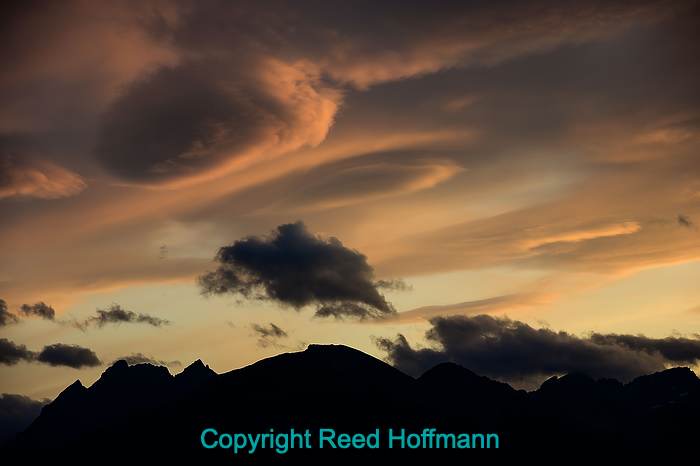
On our final night at bear camp, we were treated to a beautiful sunset while out on the platform waiting for bears. The long days certainly worked to our benefit. Nikon Z 7, Aperture Priority, ISO 250, 1/200 at f/5, EV +.3, Nikkor 24-120mm lens at 105mm.
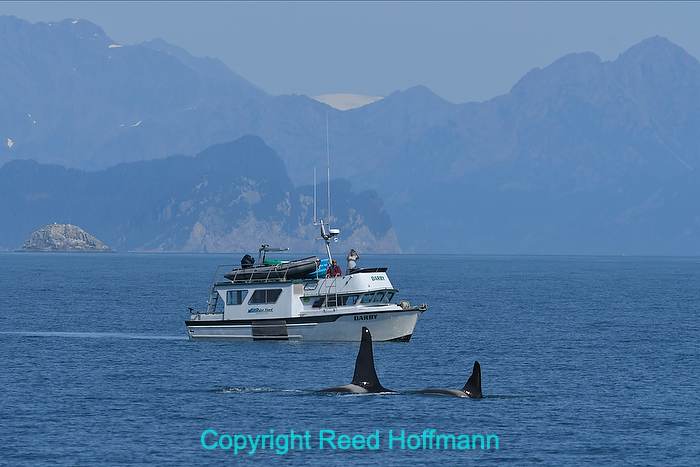
On our second to last day, we went to Seward and boarded a large boat for a day of wildlife viewing in Kenai Fjords National Park. Early in the voyage we came across a pod of orcas, and spent about thirty minutes following them. While I was able to get some tighter shots, I liked this best as it showed a bit of where we were. Nikon D500, Aperture Priority, ISO 250, 1/1600 at f/5.6, EV 0.0, Nikkor 200-500mm lens at 260mm.

We saw, and were able to make photos of three different types of puffins. This was my first time seeing both the tufted puffin (here with lunch) and the parakeet puffin. Nikon D500, Aperture Priority, ISO 400, 1/1600 at f/5.6, 0.0 EV, Nikkor 200-500mm lens at 500mm.

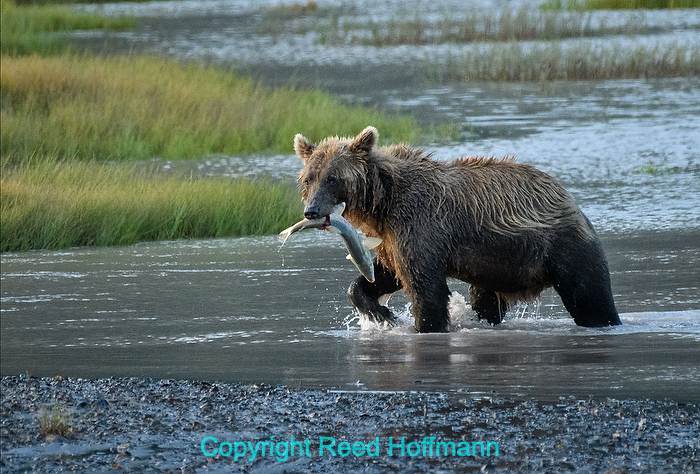
Beautiful photos Reed. Kind of different experiences I have had on my trips and visits to Lake Clark National Park. The 3 times I’ve been there it was later in the month of August. Each trip and visiit we had different Brown Bear experiences and photo oportunities. The 1st time we had days of rain, very hard to shoot. You are 100% correct in usng only minimum lenses. I am very impressed with the high quality of the photos you were able to capture with the Nikkor 200-500 on the D500. That wouild make it a 260mm to 650mm. Are my calculations correct? Thank you for sharing your wonderful photos. I also admire your honestly about taking many, many photos to only get a few sharp ones.
Hi Joel. The 200-500 on a DX body is the equivalent to a 300-759 (1.5X) on a full-frame. I love that lens. While I have a 200-400mm f/4, the extra reach and smaller size of the 200-500 mean I haven’t take 200-400 on a wildlife trip since the 200-500 came out and I bought it.
Awesome photos and awesome blog. Glad you were able to visit my favorite state!
Thanks Reed-a great narrative & terrific photos!. This sounds like a wonderful trip! ‘Appreciate your sharing.
Thanks Norm, I both enjoy leading the trips and telling folks about them.
Great blog Reed–loved it! I also loved this trip and was thrilled we had this opportunity of a lifetime. You’re a wonderful teacher and mentor. Thanks for all your help.
So glad you and Robbie were able to join us on this adventure. Looking forward to the next one!
Great images Reed! And super cool article with all the details of your adventure! Well done!
Thanks J. Scott.